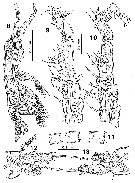|
|
 |
Fiche d'espèce de Copépode |
|
|
Monstrilloida ( Ordre ) |
|
|
|
Monstrillidae ( Famille ) |
|
|
|
Monstrilla ( Genre ) |
|
|
| |
Monstrilla marioi Suarez-Morales, 2003 (M) | |
| | | | | | | Ref.: | | | Suarez-Morales, 2003 (p.63, figs.M); Suarez-Morales & Castellanos-Osorio, 2019 (p.120, 121) |  issued from : E. Suarez-Morales in Bull. Mar. Sc, 2003, 73 (1). [p.64, Figs.1-6]. Male (from Banco Chinchorro, Mexico): 1, 3, habitus (ventral and dorsal, respectively); 2, head (ventral); 4-5, genital apparatus and lappets (lateral and ventral, respectively); 6, P1; 7, caudal rami (dorsal). Nota: Cephalothorax (incorporating 1st pedigerous somite)) accounting for 37.8 % of total body length. Anterior part of forehead flat, with 2 short, slener sensillae. Oral papilla lying midventrally 0.37 of way back along cephalothorax, not protuberant. Nauplius eye present, weakly developed, ocelli large, with rounded shape, separated by distance aqualling one eye diameter. A1 5-segmented, slightly longer than 87 % of cephalothorax length, and about 33.5 % of total body length. Pedigerous somites 2-4, together accounting for 38.3 % of total length in dorsal view. Posterior margin of intercoxal sclerite of legs P1-3 with process on diagonal division articulating with large, rectangular coxa along diagonal line. P5 reduced, represented by a bud-like protuberance visible in latreral view, protuberance formed by 3 lobes of different sizes. Genital complex with 2 terminal lappets corrugated, both lappets end in a short, single seta. Urosome consisting of 5 somites (5th pedigerous somite, genital double-somite and 3 free abdominal somites, accounting for 19 % of total body length. Caudal rami subrectangular, about 1.3 times as long as wide, widely divergent, bearing 4 setae (2 terminal, 1 outer lateral seta and 1 inner seta).
|
 issued from : E. Suarez-Morales in Bull. Mar. Sc, 2003, 73 (1). [p.66, Figs.8-13]. Male: 8, habitus (lateral); 9-10, right A1 (ventral and dorsal, respectively); 11, intercoxal sclerite of P1 to P3; 12, P3; 13, P4. Nota: The spine-like processes on the intercoxal sclerite have not been described previously in the group. The shape and structure of these sclerites can have different forms and ornamentation, such as the patches of spinules present in an undescribed species, but its taxonomical value has not been explored.
|
 issued from : E. Suarez-Morales in Bull. Mar. Sc, 2003, 73 (1). [p.65] Male: Armature formula of swimming legs P1 to P4. Roman numeral = spine; arabic numeral = seta.
| | | | | NZ: | 1 | | |
|
Carte de distribution de Monstrilla marioi par zones géographiques
|
| | | | Loc: | | | Mexico (Yucatan) | | | | N: | 1 | | | | Lg.: | | | (936) M*: 1,55-1,72; {M: 1,55-1,72}
* Caudal rami excluded. | | | | Rem.: | According to Suarez-Morales (2003, p65) the most striking characteristic to distinguish this species from all its congeners is the structure of the genital complex and the structure of P5. | | | Dernière mise à jour : 24/02/2020 | |
|
|
 Toute utilisation de ce site pour une publication sera mentionnée avec la référence suivante : Toute utilisation de ce site pour une publication sera mentionnée avec la référence suivante :
Razouls C., Desreumaux N., Kouwenberg J. et de Bovée F., 2005-2025. - Biodiversité des Copépodes planctoniques marins (morphologie, répartition géographique et données biologiques). Sorbonne Université, CNRS. Disponible sur http://copepodes.obs-banyuls.fr [Accédé le 22 octobre 2025] © copyright 2005-2025 Sorbonne Université, CNRS
|
|
 |
 |





